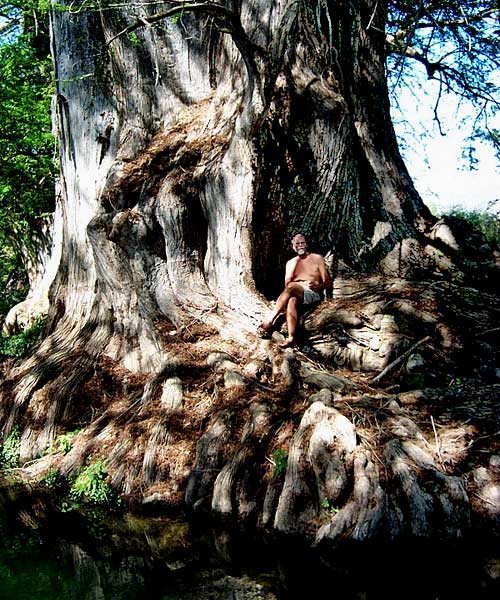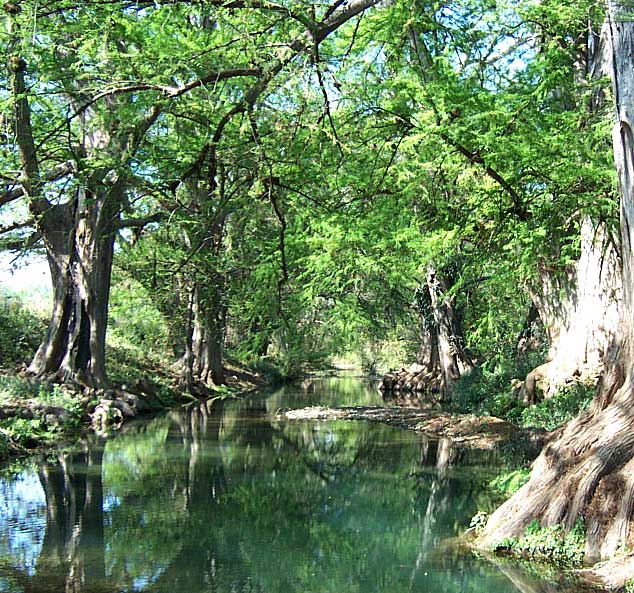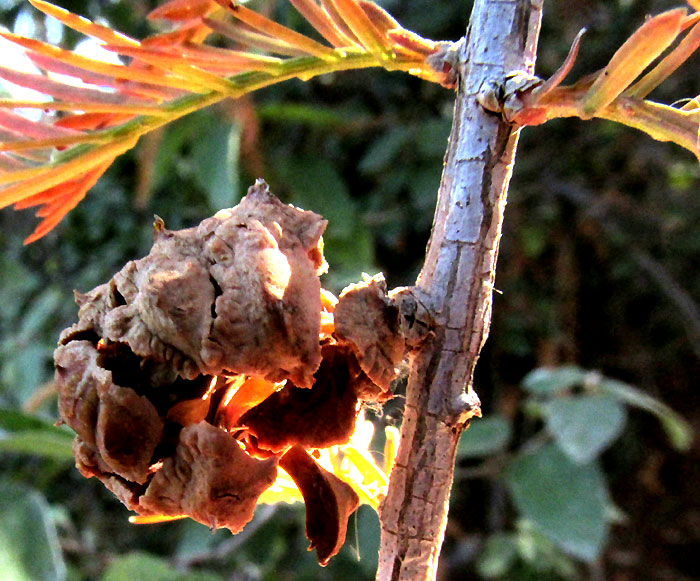Excerpts from Jim Conrad's
Naturalist Newsletter
from the March 3, 2007 Newsletter issued from Sierra Gorda Biosphere Reserve, QUERÉTARO, MÉXICO
THE MONTEZUMA CYPRESSES OF EL SABINAL

El Sabinal is near Jalpan, Querétaro. The name "El Sabinal" means "Place of the Cypresses," the local Spanish name for cypress being "Sabino." They're also called "Ahuehuetes." In English we call the species at El Sabinal "Montezuma Cypress." It's TAXODIUM MUCRONATUM we're talking about.
Though few Montezuma Cypresses grow in English- speaking territory (only southernmost Texas, which also is mostly Spanish speaking), this species has an English name because it's so extraordinary that even English speakers talk about it. The above picture of me sitting at the base of one shows why.
Montezuma Cypresses aren't particularly tall, but the bases of their trunks are enormous! Moreover, I've seen them with trunks even larger than ours. Near Mitla Ruins in Oaxaca a tree known as the Tule Cypress is 140 feet tall, with a trunk between 35 and 40 feet in diameter. It's listed as "The world's widest tree," though there's a debate about whether the Tule Cypress is a single tree. It has its own Wikipedia page.
Montezuma Cypresses aren't real cypresses, genus Cupressus, but rather baldcypresses, genus Taxodium, though they're in the same gymnosperm family, the Cypress Family, the Cupressaceae. Unlike closely related Baldcypresses of Southeastern US swamps, Montezuma Baldcypresses aren't necessarily swamp trees. They need plenty of moisture, but often you find them on mountain slopes, frequently as individual trees in sheltered, moist coves.
This is Mexico's National Tree. I don't think Mexicans give this species such status only because it's so big. Wherever the trees grow there's always a special feeling. The feeling at El Sabinal last Saturday was one of profoundly lush, summery restfulness. The picture below captures a little of that feeling:

Note from January 1, 2023, issued from near Tequisquiapan, elevation about 1,900m (6200 ft), ~N20.57°, ~ W99.89°, Querétaro state, MÉXICO
MONTEZUMA CYPRESS CONE OPENING

The above picture shows one of the Montezuma Cypress's typically small cones, only about 2cm long (0.8 inch). At this season the cone is dropping its yellowish-brown, winged seeds, one of which is visible inside the cone where one of the thick, woody scales has fallen away. Each scale produces two seeds. Notice that the tree here at the beginning of the dry season before any frosts have occurred still bears leaves, though many others are falling at this time, and they are brown -- looking golden and very pretty in bright morning sunlight. The individual leaves are the small, sharp-pointed items attached to their own special kind of stem, which may or may not fall off with their little leaves.
This particular tree grows along a shallow ravine that's always dry, except after rains and when big farmers upstream don't pay attention to their irrigated field so that water overflows their fields and drains down the ravine -- an event all too common, in terms of wasted pumped groundwater and wasted electricity pumping the water. I'm unsure if this tree is planted or natural. It's the only one in the area, a small one maybe twenty years old, yet the habitat seems suitable for the species.